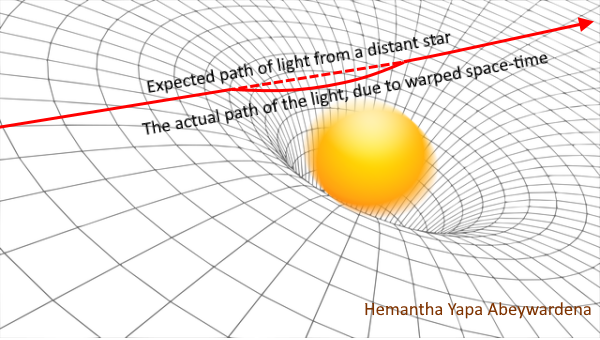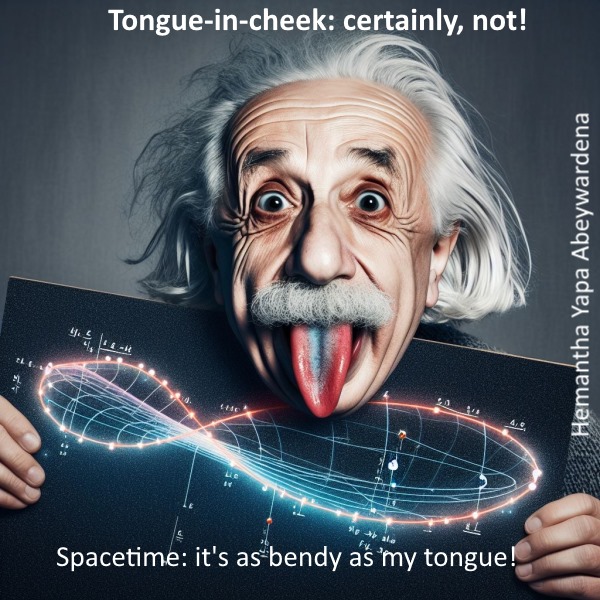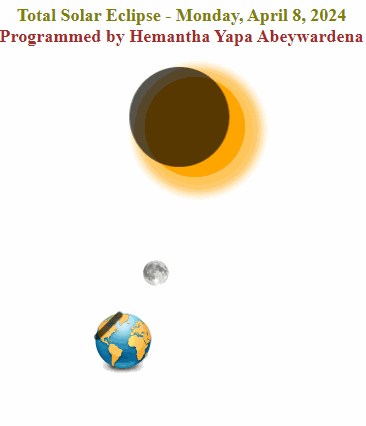The Sun goes on vacation! – the total solar eclipse 2024 – By Hemantha Yapa Abeywardena, United Kingdom
 The lucky folks along a relatively narrow geographical band, from Mexico all the way to Canda, are going to witness a rare celestial spectacle on Monday, April 8 – a total solar eclipse. The path of totality – where people can witness total darkness – cuts across fifteen US states, before rolling into Canada in its final mesmerising leg.
The lucky folks along a relatively narrow geographical band, from Mexico all the way to Canda, are going to witness a rare celestial spectacle on Monday, April 8 – a total solar eclipse. The path of totality – where people can witness total darkness – cuts across fifteen US states, before rolling into Canada in its final mesmerising leg.
In mathematical proportion to the excitement, the enviably famous American entrepreneurial spirit has already gone into full swing: the hotel bookings, closer to the path of totality, have gone up exponentially and so have the prices; in addition, traders lost no time in springing into action in promoting related merchandise and of course, safety goggles, while implying that exercising caution before looking heavenward is a virtue, indeed.
The excitement that borders on ecstasy is perfectly understandable: astronomical charts show that there will not be another total eclipse for twenty years that could be viewed from the US; in the United Kingdom, the next total solar eclipse will only occur in 2090! Of course, there will be partial solar eclipses at different global locations in the future, but they cannot instil the same, inexplicable, magical sentiment of a total eclipse.
A solar eclipse occurs when the Moon blocks sunlight from reaching the Earth, while moving between the star and our planet. Although the Moon passes across the region in question many times a year, the occurrence of the three celestial objects being in the same plane is rare – a necessary condition for a total solar eclipse: since the orbit of the Moon around the earth is slightly elevated by a few degrees from the orbit of the Earth around the Sun, they do not frequently line up to trigger off a full solar eclipse.
Up until the age of reason dawned, humanity’s flawed takes on the eclipses had been evolving, while giving hilarious overtures for the future generations to ponder.
The Chinese, for instance, thought that a large celestial serpent was having an unusually large meal, when the Sun went missing all of a sudden, in the middle of the day during a total solar eclipse. Understandably, they did what humanly possible on the surface of the Earth in the dark: they beat pots and pans, frow dawn to dusk, in order to scare off the invisible dragon in menacingly high pitch – and succeeded in the pursuit, when the Sun came back!
The Vikings, who ruled over the British Isles in the Middle Ages with an iron fist, once the Romans left, thought that the total solar eclipse was due to a tug-of-war between the Sun and the Moon. Having recognized that the Moon being the weaker of the two, they lent their support by chanting and directing their poisoned spears at the stronger, the Sun. When the total solar eclipse ended in a very short period of time, the Vikings could not be happier over their latent strength that stemmed from the cacophony of the noises, eclipsing the famous pragmatism that they were renowned for.
Perhaps this may have been the real beginning of the notion associated with the Brits today: supporting the underdogs, be it in cricket, football, rugby and sometimes, of course, in military conflicts too, but a bit controversially.
The Mayans did predict solar eclipses too. Their calendar, however, ended at a certain point in their defined time, leaving what followed only to be open to interpretation by the future generations.
Even Sri Lankans, according to our own parents, did not fail to make their own contribution to the annals of history of total solar eclipses: when the darkness fell all of a sudden on April 8, 1959, forcing animals and birds into unexpected chaos, some highly ambitious members of the fair sex had been persuaded to drink a juice made from sweet myrtle, locally known as ‘wada kaha’, by questionable medicine men to enhance the beauty of the vulnerable souls; instead of beautifying the women in question, they had been forced to make frequent trips on a single day to the hole in the ground those days, while taking extra measures to hide the embarrassment on many fronts.
With the arrival of the Age of Reason, the great thinkers managed to account for the Sun being blocked for a few minutes during a solar eclipse – finally. Even they, however, could not resist the creation of a bit of drama associated with the event! They used the term, ‘corona’, believing the existence of a mysterious glow at the periphery of the Sun, only to be exposed during a total solar eclipse.
In short, they wanted it to be known as a source of regal connotations – something that was akin to a crown.
How Einstein hit the jackpot during a total solar eclipse
In 1915, Albert Einstein, who has since become a synonym for human intelligence, proposed his General Theory of Relativity. Einstein, in his theory, claimed that the attraction of celestial bodies, such as the Sun and Earth, was not caused by a force, as described by Sir Isaac Newton in his famous Law of Gravitation.
According to Newton, the force of attraction between any two objects in the universe, is dependent of the masses of each object in question and the distance between them: the greater the mass, the greater the force; the smaller the distance, the greater the force.
Einstein, however, disputed mathematics involved in the equation and of course, the theory for that matter.
While kicking up a storm – that later grew into a hurricane in a short passage of time – or in spacetime, to be more precise – in the scientific circles – and beyond – he claimed that the attraction of planets towards the Sun was due to space – spacetime, as he did not refer to space and time in isolation – being warped around the Sun due to its sheer weight, exactly like the dip of trampoline when someone is at its centre.
When an object passes close to a heavy object in spacetime, said Einstein, that the object just ‘falls’ towards the latter by virtue of the bendy ‘curvature’ of spacetime, not due to a force of attraction determined by a mathematical equation, regardless of its simplicity – F = GMm/d².
Even the intellectual giants of the early 20th century could not get their heads around the novel concept of space being bent. The existence of endless mathematical formulae did not help either.
Against this backdrop, the total solar eclipse that occurred on May 29, 2019 came as a bolt from the blue!; it paved the way for the ultimate verification of Einstein’s untested General Theory of Relativity, taking it off the hypothetical realm: two expeditions, led by the famous astronomer and physicist, Arthur Eddington from Cambridge University, were sent to Brazil and an island off African coast, to study the paths of light from distant stars in the absence of sunlight during the total solar eclipse in question: three data sets were collected; two sets were subjected to rigorous analysis by the great minds at that time, while the third was discarded – that later turned out to be really controversial – as a catalogue of anomalies.
On November 19, 1919, six months after the total eclipse, Eddington and the team announced their results that in turn took the world by storm: the observations were consistent with Einstein’s prediction by the General Theory of Relativity; light from distant stars did bend while moving closer to the Sun due to the curvature of spacetime! The measurements were very close, but not exact.

Not only did the results confirm the much-needed verification of Einstein’s new idea of spacetime – and its curvature caused by heavier heavenly objects – but also elevated Albert Einstein to a social status that is normally akin to a celebrity, something that exists to date.

As far as the total eclipse that is going to take place on Monday is concerned, unlike our ancestors who saw it as bad omen, it is going to be a springboard for taking a deep dive into the scientific exploration.
Not only is NASA going to stream the event live, but also planning to fire rockets into the atmosphere in order to probe the potential changes during the total eclipse. In addition, citizen scientists beyond the path of totality are encouraged to take photos and share them with peers and of course, on social media, to see unexpected developments, if any, during the celestial spectacle.
All in all, the total solar eclipse is going to show us that the potential of heavenly bodies to surprise us and entertain simultaneously, despite us being in a better state to grasp the endless wonders that they have been throwing at us since the dawn of time – spacetime, in honour of the great man, Albert Einstein.








